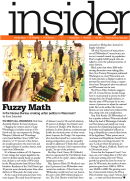by Eric Schneiderman and Tedra Cobb,
May 28, 2008
May 27, 2008
Diana Hynek
Departmental Paperwork Clearance Officer
Department of Commerce, Room 6625
14th and Constitution Avenue, NW
Washington, DC 20230
VIA ELECTRONIC MAIL: dHynek@doc.gov
Re: Collecting the addresses of incarcerated people in the 2010 Census
Dear Ms. Hynek,
We are writing to urge the United States Census Bureau to collect the home addresses of all incarcerated persons in the 2010 Census. In October 2007, we sent then director Kincannon a letter co-signed by 30 federal, state and local legislators requesting that the Bureau change how it counts the prison population. Counting people in prison at their pre-incarceration address is essential for compliance with the “One Person, One Vote” rulings of the Supreme Court, which require that legislative districts at every level of government contain equal numbers of residents in order to ensure fair and equal representation for all. The Census is uniquely suited to perform this function, which will help us better serve our constituents, our states, and our country.
Currently, the Census Bureau includes everyone housed in federal, state, and local prisons in its count of the general population of the Census block that contains the prison. State laws, however, often define residence as the place where one voluntarily lives. Many states also have constitutional clauses or election law statutes that explicitly declare that incarceration does not change a residence. Prisoners therefore remain legal residents of their pre-incarceration addresses, and in situations where they retain voting rights, they send absentee ballots to their home districts. Unfortunately, the current census methodology opts to disregard this, instead counting a significant proportion of our national population in the wrong place. Crediting the population of prisoners to the Census block where they are temporarily and involuntarily held creates electoral inequities at all levels of government.
In our letter, we asked the Census Bureau to permanently eliminate this problem by counting people in prison as residents of their home addresses. Recognizing that time was short, we asked the Bureau to implement, as an interim solution, the recommendation of the National Research Council, and publish a special version of the PL94-171 redistricting data file for the prison population. Publishing detailed block-level counts of prison populations would empower legislators to remove those populations prior to redistricting. New York has relatively good record keeping procedures tracking the home addresses of inmates, but it is ultimately the duty of the U.S. Census Bureau to provide this information in a usable format for State and County Legislators. Furthermore, not all states find themselves with the same level of resources to locally correct this failing on the part of the Federal Census Bureau.
Unfortunately, we did not receive a positive response from then-Director Kincannon. On November 20, 2007 Director Kincannon wrote that the Bureau was not intending to change its method of counting the prison population. His arguments were based on the Census Bureau’s 2006 report, “Tabulating Prisoners at Their Permanent Home of Record Address,” the findings of which were rejected by the Census Bureau’s own commissioned experts at the National Research Council later that year. The Director’s response also failed to address our request for a special version of PL94-171 to facilitate data correction.
While it is true that improving the accuracy, fairness and utility of the census by changing how incarcerated people are counted would create an additional burden on the Bureau, we feel that the Bureau is making the burdens seem more significant than they really are.
For example, the Census Bureau argued that:
If a valid residential address (i.e., a complete address that can be verified to exist) were provided, the Census Bureau would have to verify the validity of tabulating the prisoner at that address which would require a new census operation to interview the current residents of the address.
The solution need not be so difficult. The Bureau could simply count prisoners the same way that people in non-institutional group quarters like migrant farmworkers, people in hostels, and members of religious orders: Count prisoners at the facility only if they do not report a usual and valid address elsewhere.
Likewise, the Census Bureau has argued that collecting home residence information would be difficult because it does not exist in a complete and usable form in administrative records. While the Census Bureau should certainly respond to the National Research Council’s repeated criticism of the Bureau’s over-reliance on administrative records to enumerate group quarters populations, the Census Bureau’s response runs to an opposite extreme. Interviewing an estimated 2.6 million incarcerated people in a private and confidential room would indeed be an expensive, time consuming and difficult operation. To date the Bureau has been reluctant to consider solutions based on its successful practice in other parts of the Census: use individual forms in most cases, and conduct in person interviews or indirect means of collecting the data only where necessary.
Given the Bureau’s failure to take concrete steps to change how incarcerated people are counted in the 2010 Census, we concede that the full reform we seek is difficult to realize in the 2010 Census. But time still exists for two very important steps.
First, the Census Bureau should adopt the recommendations of the National Research Council and conduct experiments during the 2010 census as part of a major research and testing program to evaluate assigning incarcerated people to other addresses outside the facility. The 2010 enumeration is an opportunity that should not be missed to test improvements.
Second, we again repeat our request that the Bureau implement as an interim solution, the recommendation of the National Research Council, and publish a special version of the PL94-171 redistricting data file for the prison population. Publishing detailed block-level counts of prison populations would empower legislators to remove those populations prior to redistricting. Again, Director Kincannon did not address this portion of our proposal in his November 2007 letter.
This special dataset would greatly assist counties and states with large prisons to drawing fair districts. The interest in an alternative tabulation is clear. Thirteen counties in New York already manually remove the prison population prior to redistricting, as do counties in Alabama, California, Colorado, Georgia, Illinois, Florida, Michigan, Mississippi, Oklahoma, South Carolina, and Virginia. Many of the counties that retain the prison populations do so only because they are unaware that prisoners are included in the Census, because they feel obligated to use the Census, or because they do not know how to adjust the data.
To manually adjust the Census, counties must rely on incompatible Department of Corrections data or on Summary File 1 data which is published several months after PL94-171. Jurisdictions covered by Section 5 of the Voting Rights Act have particular difficulties because they must often start — if not also complete — redistricting prior to the publication of Summary File 1. Further, these jurisdictions find it difficult to reconcile the partially incompatible racial and ethnic classifications in PL94-171 with the data published for correctional populations in Summary File 1. The Census Bureau is uniquely suited to eliminate these problems.
Publishing an alternative version of PL94-171 dataset that contained just the prison population at their prison addresses is well within the Bureau’s capabilities. There is no impact on data collection procedures and it requires only the publication of a small amount of data in a different format several months earlier than the Bureau would have done otherwise. Of the 8 million Census blocks in Census 2000, less than 6,000 contained a correctional facility. We are asking that the four tables in the PL94-171 redistricting data set be recalculated and published separately to show only the correctional populations in those 6,000 blocks. With this special tabulation, data users would be empowered to decide whether they want to draw districts based on the prison populations without wrestling with the technical questions. By subtracting one data set from another, data users can have a complete and accurate count of their population without the prisoners skewing the data.
This is not an ideal solution, but it is one that is well within the means of the Census Bureau to implement at this late date. We respectfully urge the Census Bureau to take all steps possible to help reduce and eventually eliminate the political inequities and unnecessary data complications that result from the flawed practice of counting people in prison as residents of the census block that contains the prison.
Sincerely,
Eric Schneiderman
New York State Senator, 31st District
Ranking Minority Member,
Senate Codes Committee
80 Bennett Avenue, LA
New York, NY 10033
Phone: 212-928-5578
Fax: 212-928-0396
Tedra L. Cobb
Vice-Chair
St. Lawrence County Legislature
District 8
365 Townline Road
Hermon, NY 13652
(315)386-4928 Phone and Fax
cc:
Steve H. Murdock, Director, U.S. Census Bureau
Frank Vitrano, U.S. Census Bureau
Catherine M. McCully, U.S. Census Bureau
Footnotes

 You might call Wisconsin’s 53rd State Assembly District the land of prisons. Hugging the western shore of Lake Winnebago, it includes sections of Oshkosh and also encompasses the Dodge, Waupun, Oshkosh and Winnebago correctional facilities. Some 5,000 “constituents,” or 9.5 percent of the district, are actually prisoners who don’t vote and are legal residents of another district, with many from Milwaukee.
You might call Wisconsin’s 53rd State Assembly District the land of prisons. Hugging the western shore of Lake Winnebago, it includes sections of Oshkosh and also encompasses the Dodge, Waupun, Oshkosh and Winnebago correctional facilities. Some 5,000 “constituents,” or 9.5 percent of the district, are actually prisoners who don’t vote and are legal residents of another district, with many from Milwaukee. 




